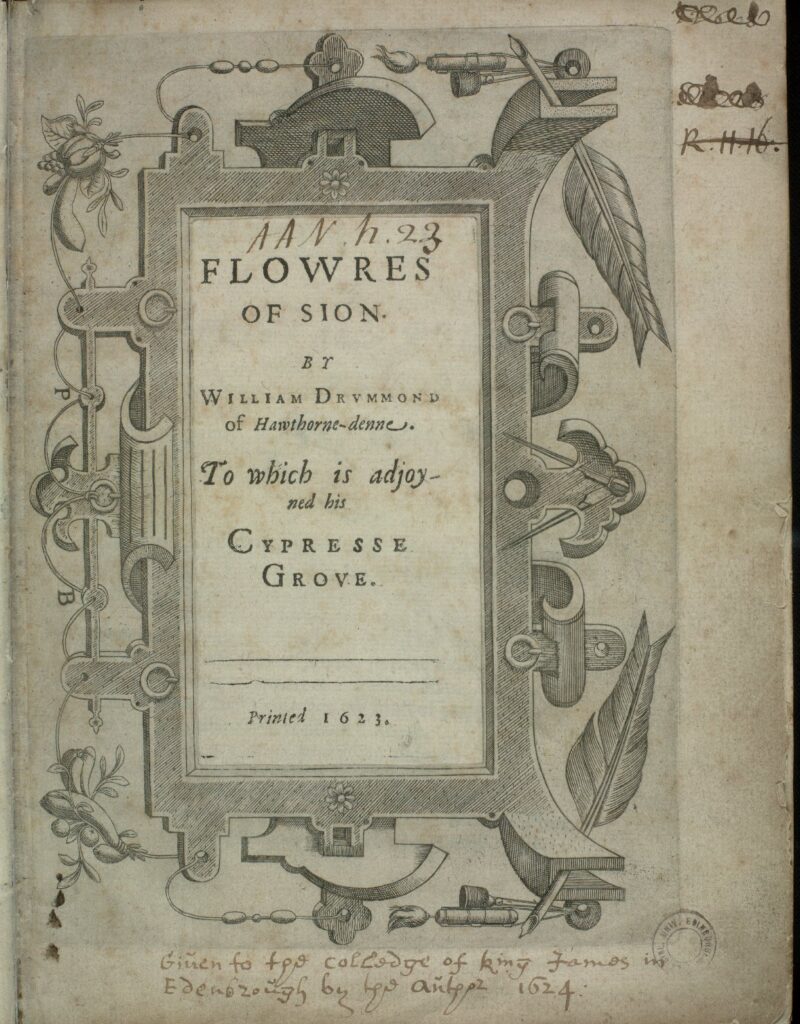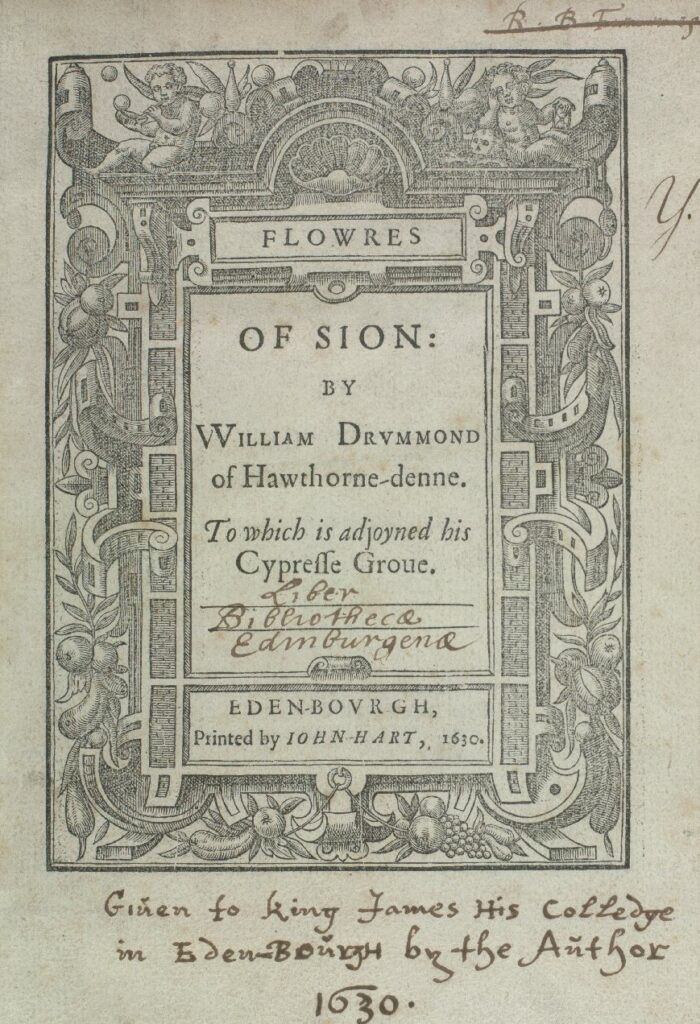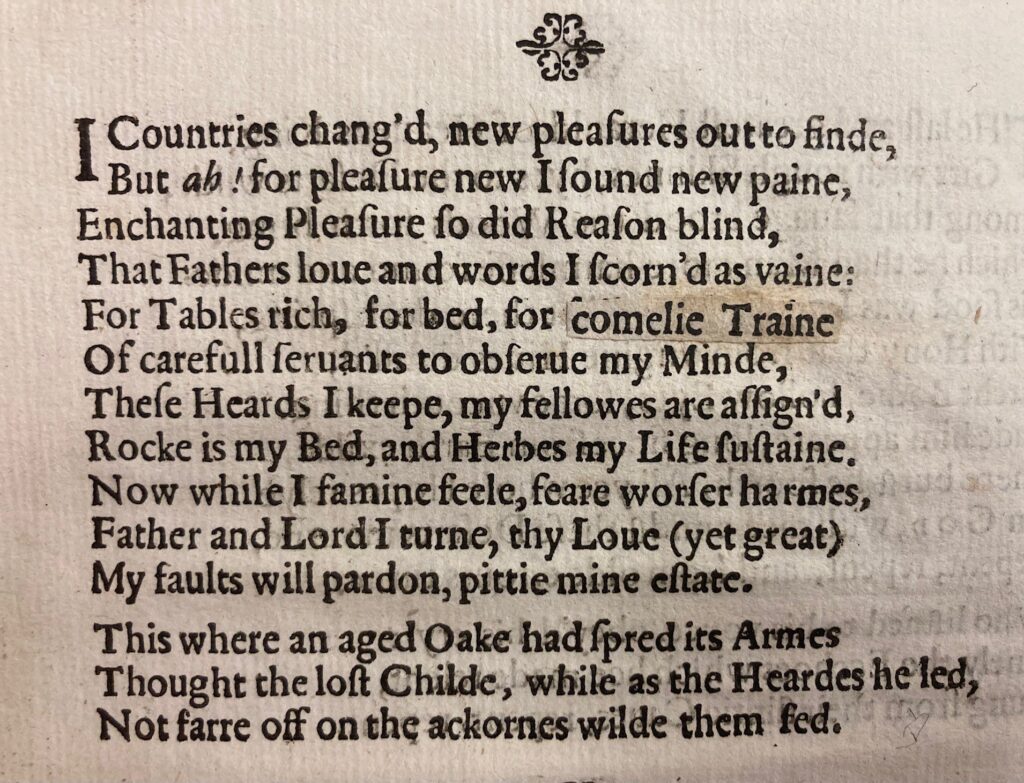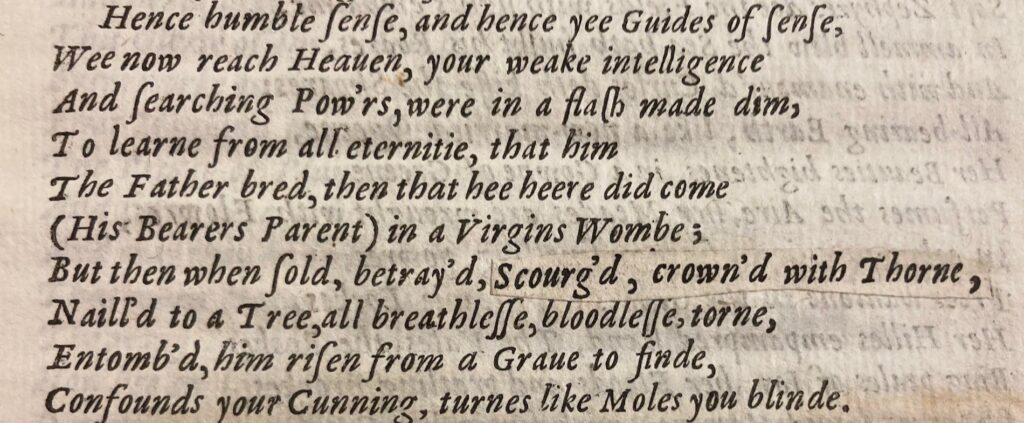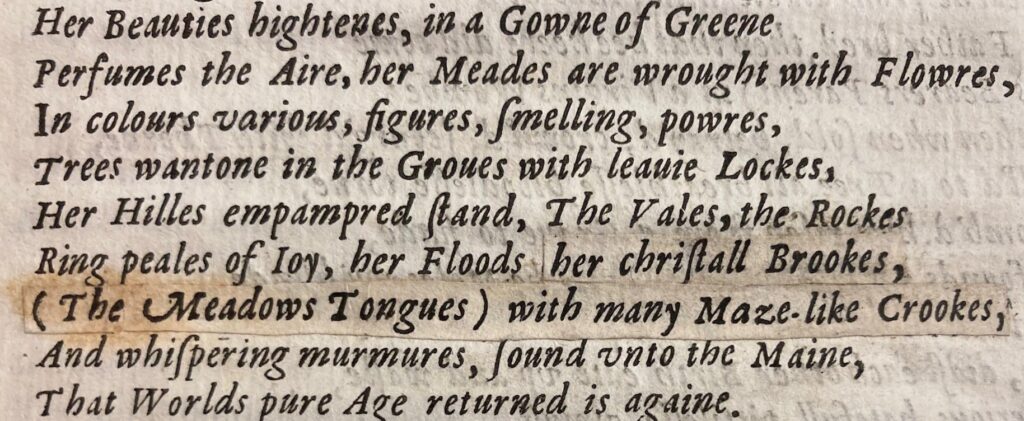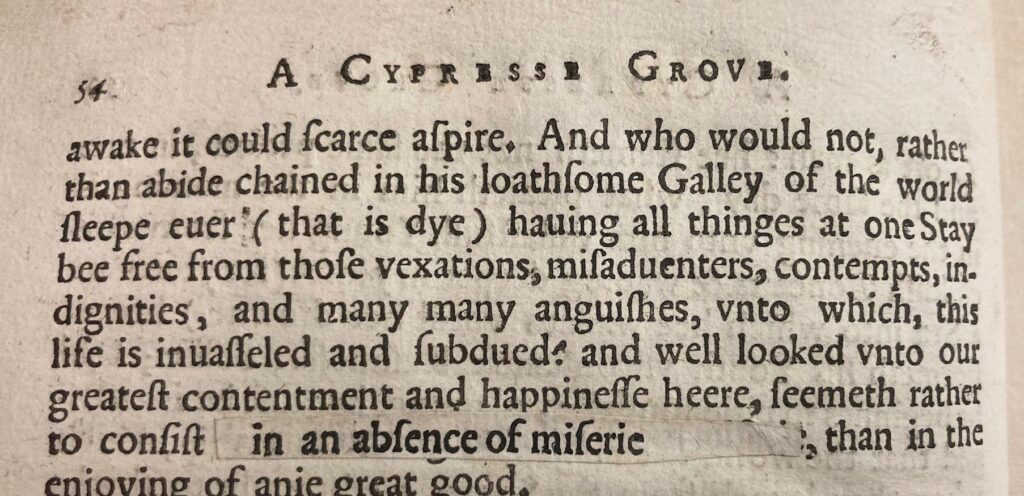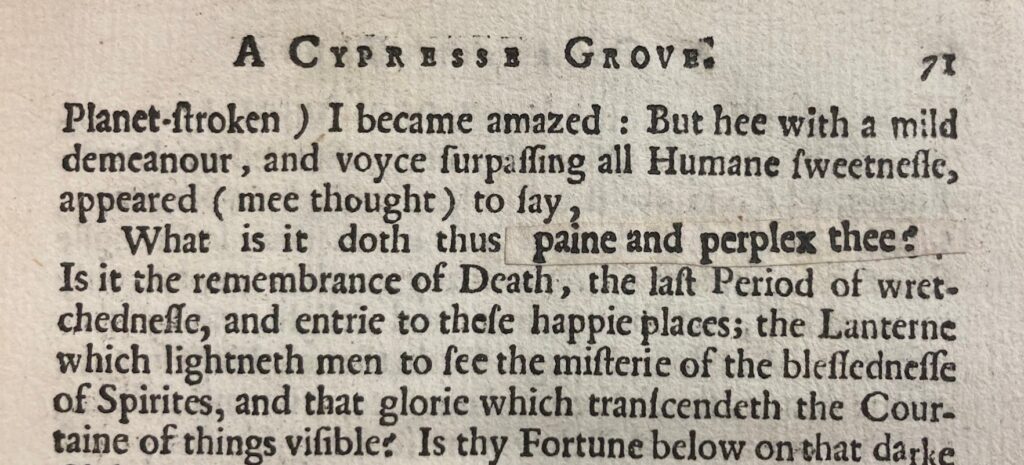Home University of Edinburgh Library Essentials
July 26, 2024
William Drummond’s ‘Flowres of Sion’: A Unique Copy of a Major Work
Posted on February 13, 2023 | in Library & University Collections, Scottish Literary Collections | by pbarnabyThis year marks the quatercentenary of the publication of Flowres of Sion (1623), an important volume by William Drummond of Hawthornden (1585-1649), one of Scotland’s major 17th-century poets and one of Edinburgh University Library’s greatest benefactors.
William Drummond of Hawthornden
An alumnus of Edinburgh University, Drummond started collecting books shortly after he graduated in 1605. He assembled a superb private library, which ranged widely across the fields of literature, history, geography, philosophy, theology, science, medicine and law. From the mid-1620s, he began gifting works from his library to his alma mater, eventually donating over 600 volumes. Drummond thus provided Edinburgh University Library with some of its greatest treasures, including two Shakespeare quartos and works by Ben Jonson, Edmund Spenser, Michael Drayton (a close friend of Drummond), and Sir Philip Sidney.
Drummond’s also donated copies of his own works, including a unique copy of the first edition of Flowres of Sion (De.4.53), along with the revised and expanded second edition of 1630 (De.4.113).
- First edition of ‘Flowres of Sion’ (1623), with inscription donating the volume to Edinburgh University Library.
- 2nd edition of ‘Flowres of Sion’ (1630), again with inscription.
Flowres of Sion
Flowres of Sion is a verse sequence consisting of 25 sonnets, 5 madrigals, and 3 songs. The overarching theme is Drummond’s conviction that nothing is constant in a changing world but change itself. In poem after poem, he contrasts human fallibility with Christ’s triumph over death, the mutability of the natural world with the permanence of God, and the constant disillusions of human life with the consolations of religion. He thus resolves to renounce worldly pleasures and devote himself to spiritual matters. These themes are perhaps most succinctly expressed in the programmatic opening sonnet, where Drummond undertakes to lift his thoughts above this ‘restlesse world’ and fix his mind on Christ’s eternity:
All only constant is in constant change,
What done is, is undone, and when undone,
Into some other figure doth it range,
Thus rolles the restlesse World beneath the Moone:
Wherefore (my Minde) above Time, Motion, Place,
Thee raise, and Steppes not reach’d by Nature, trace.
Given that many of the poems are translations or adaptations of Italian or French originals, we should perhaps be wary of overstressing autobiographical factors. There are, however, compelling reasons why themes of impermanence and mortality may have come to dominate Drummond’s verse. In 1620, he survived a near-fatal bout of pleurisy, and in 1623, Scotland was struck by catastrophic famine, which saw Drummond lose several dear friends. This surely explains why Flowres of Sion also includes a lengthy prose meditation on the fear of death entitled ‘The Cypress Grove’. Here Drummond concludes that if we desire to be free of suffering, but life brings nothing but suffering, then we must learn to live detached from life.
Edinburgh University Library’s Unique Copy
The first edition of Flowres of Sion was privately printed for distribution among Drummond’s friends. Three separate issues have been identified, each with a different title-page. None of these names the place of publication or the printer, but the distinctive ornaments clearly reveal that all were printed by Andro Hart of Edinburgh. The Edinburgh University Library copy is the only known example of the third issue. It is also unique in another respect. It contains many corrections on printed slips of paper pasted over the original lines. These amendments were presumably made by Drummond himself after the book was originally issued. The great majority of these corrections (21 out of 24) were adopted in the second edition of Flowres of Sion (1630).
In some cases, the amendments correct redundancies in the original text. In the two sonnets below, Drummond amends ‘There he is swadl’d in Cloathes’ to ‘There is hee poorlie swadl’d’ (p. 5) and ‘following traine’ to ‘comelie Traine’ (p. 8). Drummond presumably felt that ‘in cloathes’ and ‘following’ were already implied by ‘swadl’d’ and ‘traine’ and opted for more expressive alternatives.
In other cases, Drummond amends errors or, at least, wording that might be read as erroneous. Thus, in the first case below, a description of Christ as ‘crown’d, scourg’d with Thorne’ is corrected to ‘scourg’d, crown’d with Thorne’ (p. 15). Elsewhere, Drummond introduces alliteration to create a more mellifluous text. So, in the second example below, he amends the original text ‘her prattling Brookes, / (Starres liquid Mirrors) with serpinting Crookes’ to the more freely-flowing ‘her christall Brookes, / (The Meadows Tongues) with many Maze-like Crookes’ (p. 16).
Drummond also inserts changes to the text of ‘The Cypress Grove’. In the first passage below, he opts for a more succinct rewording. In the original text, happiness on earth ‘seemeth rather to consist in the being released from miserie, than in the enjoying of anie great good’ (p. 54). In the revised text, the highlighted words are replaced by the punchier in the absence of miserie.
In the second passage below, alliteration again produces a more mellifluous text. In the original text, a figure in a dream vision asks Drummond: ‘What is it doth thus anguish and trouble thee?’ (p. 71). In the pasted-in correction, these last words become paine and perplex thee.
Other changes remove ambiguities, iron out obscurities, and standardize (or Anglicize) spelling and grammar. This unique copy is, then, a remarkable record of Drummond’s continued creative engagement with the text of Flowres of Sion and ‘A Cypress Grove’ as he works towards the expanded second edition.
Further Information
For more on Edinburgh University Library’s Drummond of Hawthornden collection, see:
https://www.ed.ac.uk/information-services/library-museum-gallery/crc/collections/special-collections/rare-books-manuscripts/rare-books-directory-section/william-drummond
Bibliography
David W. Atkinson, ‘Tradition and innovation in Drummond of Hawthornden’s A Cypresse Grove’, in Scottish Language and Literature, Medieval and Renaissance, Fourth International Conference 1984: Proceedings, ed. Dietrich Strauss and Horst W. Drescher (Frankfurt: Lang, 1986), pp. 467-79.
William Drummond, Poems and Prose, ed. Robert H. MacDonald (Edinburgh: Scottish Academic Press, 1976)
William Drummond, The Poetical Works of William Drummond: With ‘A Cypress Grove’, ed. L. E. Kastner, 2 vols (Manchester: Manchester University Press, 1913)
French Rowe Fogle, A Critical Study of William Drummond of Hawthornden (New York, NY: Columbia University Press, 1952)
Robert H. Macdonald (ed.), The Library of Drummond of Hawthornden (Edinburgh: Edinburgh University Press, 1971)
David Masson, Drummond of Hawthornden: The Story of his Life and Writings (London: Macmillan and Co., 1873)
Eloisa Paganelli, La poesia di Drummond of Hawthornden (Bari: Adriatica, 1972)
Sibyl Lutz Severance, ‘”Some Other Figure”: The Vision of Change in Flowres of Sion’, Spenser Studies, 2.1 (1981), 217-28.
Michael R. G. Spiller, ‘Drummond, William, of Hawthornden (1585–1649)’, Oxford Dictionary of National Biography https://doi.org/10.1093/ref:odnb/8085
Wolfgang Weiss, ‘The Theme and Structure of Drummond of Hawthornden’s Sonnet Sequence’, in Scottish Language and Literature, Medieval and Renaissance, Fourth International Conference 1984: Proceedings, ed. Dietrich Strauss and Horst W. Drescher (Frankfurt: Lang, 1986), pp. 459-66.
Paul Barnaby, Modern Literary Collections Curator
Collections
 Archival Provenance Project: Emily’s finds
My name is Emily, and I’m the second of the two archive interns that...
Archival Provenance Project: Emily’s finds
My name is Emily, and I’m the second of the two archive interns that...
 Archival Provenance Project: a glimpse into the university’s history through some of its oldest manuscripts
My name is Madeleine Reynolds, a fourth year PhD candidate in History of Art....
Archival Provenance Project: a glimpse into the university’s history through some of its oldest manuscripts
My name is Madeleine Reynolds, a fourth year PhD candidate in History of Art....
Projects
 Sustainable Exhibition Making: Recyclable Book Cradles
In this post, our Technician, Robyn Rogers, discusses the recyclable book cradles she has developed...
Sustainable Exhibition Making: Recyclable Book Cradles
In this post, our Technician, Robyn Rogers, discusses the recyclable book cradles she has developed...
 Giving Decorated Paper a Home … Rehousing Books and Paper Bindings
In the first post of this two part series, our Collection Care Technician, Robyn Rogers,...
Giving Decorated Paper a Home … Rehousing Books and Paper Bindings
In the first post of this two part series, our Collection Care Technician, Robyn Rogers,...

